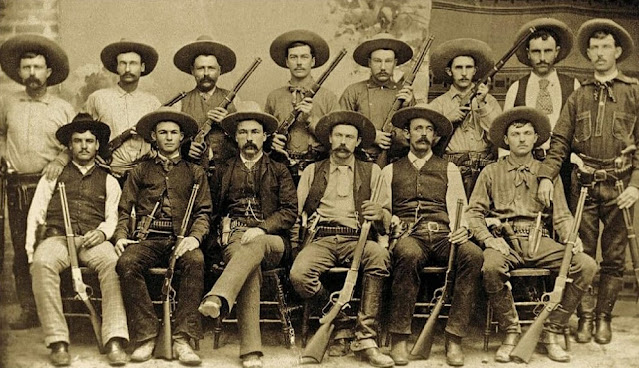On This Date In History
On October 17, 1835, Texans approve a resolution to create the Texas Rangers, a corps of armed and mounted lawmen designed to “range and guard the frontier between the Brazos and Trinity Rivers.”
In the midst of their revolt against Mexico, Texan leaders felt they needed a semi-official force of armed men who would defend the isolated frontier settlers of the Lone Star Republic against both Santa Ana’s soldiers and hostile Indians; the Texas Rangers filled this role. But after winning their revolutionary war with Mexico the following year, Texans decided to keep the Rangers, both to defend against Indian and Mexican raiders and to serve as the principal law enforcement authority along the sparsely populated Texan frontier.
Although created and sanctioned by the Texas government, the Rangers was an irregular body made up of civilians who furnished their own horses and weapons. Given the vast expanse of territory they patrolled and the difficulty of communicating with the central government, the government gave the men of the Rangers considerable independence to act as they saw fit. Sometimes the Rangers served as a military force, taking on the role of fighting the Indians that in the U.S. was largely the responsibility of the Army. At other times the Rangers mainly served as the principal law enforcement power in many frontier regions of Texas, earning lasting fame for their ability to track down and eliminate outlaws, cattle thieves, train robbers, and murderers, including such notorious bandits as John Wesley Hardin and King Fisher.
Even as late as the first two decades of the 20th century, the state of Texas continued to rely on the Rangers to enforce order in the wilder regions of the state, like the oil boomtowns along the Rio Grande. Increasingly, though, some Texans began to criticize the Rangers, arguing that they used excessive violence and often failed to observe the finer points of the law when apprehending suspects. As a result, in the 1930s, the state won control over the Rangers, transforming it into a modern and professional law enforcement organization.
On October 17, 1777, British general and playwright John Burgoyne surrenders 5,000 British and Hessian troops to American General Horatio Gates at Saratoga, New York, on October 17, 1777.
In the summer of 1777, General Burgoyne led an army of 8,000 men south through New York in an effort to join forces with British General Sir William Howe’s troops along the Hudson River. After capturing several forts, Burgoyne’s force camped near Saratoga while a larger Patriot army under General Gates gathered just four miles away. On September 19, a British advance column marched out and engaged the Patriot force at the Battle of Freeman’s Farm, or the First Battle of Saratoga. Failing to break through the American lines, Burgoyne’s force retreated. On October 7, another British reconnaissance force was repulsed by an American force under General Benedict Arnold in the Battle of Bemis Heights, also known as the Second Battle of Saratoga.
Gates retreated north to the village of Saratoga with his 5,000 surviving troops. By October 13, some 20,000 Americans had surrounded the British, and four days later Burgoyne was forced to agree to the first large-scale surrender of British forces in the Revolutionary War.
Burgoyne successfully negotiated that his surviving men would be returned to Britain by pledging that they would never again serve in North America. The nearly 6,000-man army was kept in captivity at great expense to the Continental Congress until the end of the war.
Soon after word of the Patriot victory at Saratoga reached France, King Louis XVI agreed to recognize the independence of the United States and French Foreign Minister Charles Gravier, Count de Vergennes, made arrangements with U.S. Ambassador Benjamin Franklin to begin providing formal French aid to the Patriot cause. This assistance was crucial to the eventual American victory in the Revolutionary War.
American General Horatio Gates
British General John Burgoyne











No comments:
Post a Comment